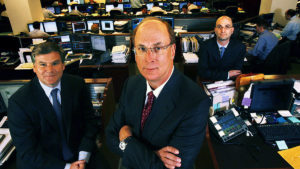When people think of the one percent, they tend to enter the realm of mythology: conjuring up images of decadent dinner parties on private islands and dogs being flown around the world in private jets. This is far from the truth. If you really want to know who they are, a good place to start is in the hidden depths of the private equity funds that have flourished with their ascent. What you’ll discover there may surprise you.
Despite its origins in the post-Second World War period, the history of private equity really begins in the Eighties, the decade in which Western countries abandoned Keynesian economic management for the small-state ethos of the neoliberal regime. Coincident with this turn was the start of a long trend of rising economic inequality. This was driven by two broad changes: the rise of the developing world, led by China, which reduced inequality between rich and poor countries. And the widening of inequality within countries, as newly liberated business owners were empowered to drive down wage bills and drive up profits. When plotted onto a graph, the result was the elephant curve. It provided a visual illustration of how, since 1980, the global one percent captured twice as much of global growth as the bottom 50%.
With ever-swelling pools of capital, this rising international class changed the way they managed their wealth. Having previously invested largely at home, spearheading the growth of national economies, the one percent globalised, shifting capital offshore to exploit the even higher returns of low-wage economies. While this stimulated the rise of a middle class in the developing world — the middle “hump” of the elephant — it also fuelled the deindustrialisation of Western countries. The working classes were shattered, one consequence being the “deaths of despair” that have been chronicled by Anne Case and Angus Deaton.
Profits, however, surged. This gave owners both more capital to invest but also, in an environment where deregulation was underway, more liberty to deploy their capital in aggressive ways. There arose a new breed of owner who was “private” in that they took over publicly-listed firms, often using borrowed money, then removed them from the stock exchange and the prying eyes of shareholders. Thereby free to do as they pleased, they could lay off workers, close shops, sell assets or transfer any debts they had used to buy the firm onto its books. The leveraged buyout was born, and the Eighties corporate raider would go on to be immortalised in the character of Wall Street’s Gordon Gekko, his “greed is good” mantra embodying the ethos of the neoliberal age.
Like the fictitious Gekko, neoliberal intellectuals maintained that enlightened self-interest, as they preferred to call it, would ultimately benefit everyone. As Bill Clinton insisted when pushing back against private equity’s critics — perhaps ominously in an interview with that celebrated do-gooder, Harvey Weinstein — private equity was helping to revive sick firms and thereby reinvigorate the economy. The story private equity’s exponents told of its virtues might have been lifted from an Ayn Rand novel, in which visionary entrepreneurs take over a moribund publicly-traded firm, get rid of the risk-averse technocrats running it, then apply the tough love it needs to turn around.
Yet there was a dark side to this new era of plutocracy. While the ascent of such barons seems reminiscent of the Gilded Age, today’s elite tend to favour a different business model from their entrepreneurial Victorian predecessors. Whereas the latter were profiting off the wrenching transition of agricultural societies into industrial ones by building things — in particular, railways — today’s elite appear parasitic by comparison. In many cases, what private equity delivers amounts to asset-stripping or consolidations that leave most people worse off, yet add little new output to the economy. This has been called “conspicuous destruction”.
A popular strategy is to acquire a firm using borrowed money, transfer the debt onto the firm, and then run down the firm to pay hefty dividends. Pioneered in the US airline industry after its late-Seventies deregulation, the Eighties would see Carl Icahn buy Transworld Airlines, load it with debt while paying himself hefty profits, and then gradually sell off its assets until it went bankrupt. That same decade, Frank Lorenzo would acquire Eastern Airlines, transfer its assets to another non-union airline he ran, then shut it down.
Of course, you don’t need a private equity front to do this, as any long-suffering Manchester United supporter will tell you (and Lorenzo similarly kept his companies public). But a big advantage of the private equity model is that, unlike United’s much-reviled owners, the beneficiaries remain hidden from public view. By the time the sewage from a privatised utility shows up on public beaches, or tenants are evicted from a council estate after its new owners convert it to luxury condos, the damage has been done.
As was the case in the original Gilded Age, today’s barons benefit from the collusion of politicians. The shift to a neoliberal policy regime made credit easier to access, deregulated the way businesses operated, and sold off state assets in the name of greater efficiency. A little-known fact of the era of low taxes is that governments were able to contain their spending by selling off the family jewels, then spending the proceeds. As a result, most Western governments now show a net negative worth on their balance sheets. Given that private equity has been a keen participant in this transfer of state assets to private hands, it looks like a terminal phase of Western capitalism, as public spaces are run down to line private pockets and poor people are squeezed hard to support the rich in their glamorous lifestyles.
But it’s actually more complicated than that. Although the growth of private equity has coincided with widening inequality, the latter has not been the sole driver of the industry. There’s another thing that has accompanied the rise of private equity: ageing societies.
When Margaret Thatcher and Ronald Reagan were elected, roughly a tenth of the population in developed countries were retired. Today that share has doubled. Meanwhile, improved health and nutrition have meant that people are living longer. Whereas the average life expectancy in Western countries was about 10 years past retirement in 1980, today that figure has more than doubled. Several Western societies have now crossed the threshold beyond which some people spend more time collecting a pension than they did working for it.
As a result, more and more people now have to be supported by a workforce which, in relative terms, is contracting. This would be challenging enough. What makes it even tougher for Western governments is that the growth of labour productivity, which was rising steadily throughout the post-war period, has now slowed to a crawl. So the hope that fewer workers could support more people by producing more is looking decidedly Pollyannish. Instead, more must be squeezed from the working population.
This can only go on for so long before something breaks. One obvious solution is to reform the pension system, by reducing benefits or raising retirement ages. But given that pensioners are among the most politically engaged in the population, politicians shy away from such decisions. Instead, they’ve tended to move in the opposite direction, as Britain has done by raising benefits. Western governments have funded the increased largesse with tax rises or cuts to other public services and, to bolster private pensions that get no state funding, policies that juice returns on asset markets, such as the loose monetary policies, privatisation and deregulation that have transferred assets to private equity.
In recent years, pension funds have collectively become the biggest investors in private equity. When tenants of a London council estate organised a rebellion against their eviction, they discovered that the new landlords were a private equity firm owned by American pension funds. Canadian pension funds occupy a similar role in Britain’s privatised water utilities, which have allowed sewage to flow into seas and rivers. In effect, tenants and workers are getting squeezed in no small measure to keep retired teachers and civil servants in the style to which they’ve grown accustomed.
It always astounds people, but it’s true: the one percent don’t exist in mythology but in our neighbourhoods, dining alongside us at our favourite restaurants and bumping into us as they walk their dogs. That’s because, statistically, any homeowner with a defined-benefit pension is part of the one percent that sits atop the global economy.
Life has recently become more difficult for private equity, as central banks abandon their easy-money policies. Returns are falling and new money is drying up, but demands for cash from investors continue. As a result, private equity firms are resorting to increasingly opaque deals, such as transferring assets across their own funds, to meet investor demands for cash. Given how unregulated private equity is, it could be storing up some nasty surprises should the markets turn sharply.
Private equity is thus coming into the crosshairs of politicians and regulators. As our leaders come face to face with the pension funds that invest in private equity, they will confront tough choices. Would private equity be too big to fail? Nobody wants to be blamed for pensioners being told their monthly payments will be frozen for the foreseeable future — but the alternative, of boosting fund values with the time-worn method of easy-money policies, looks ever less likely in an environment of persistent inflation. Major problems may therefore be brewing in the pension industry.
Indeed, pension pots would be a possible target for a tax raid, as collapsing public services across developed economies are forcing politicians to fund spending rises. Before singling them out, though, it’s worth noting that while the one percent have benefited more than most of us from the neoliberal age, their gains pale in comparison to the 0.1%. If we’re to start taxing the rich more, this would be the better place to look.
Whether or not politicians want to tackle topics such as inter-generational justice or the sustainability of the pension system, events in markets may force the question of retirement’s future onto the public agenda. Higher interest rates have begun to knock down asset values and hit profits. If this continues, fund managers will eventually have to deliver the news to their clients. That may turn out to be the nastiest surprise private equity is storing up.
Disclaimer
Some of the posts we share are controversial and we do not necessarily agree with them in the whole extend. Sometimes we agree with the content or part of it but we do not agree with the narration or language. Nevertheless we find them somehow interesting, valuable and/or informative or we share them, because we strongly believe in freedom of speech, free press and journalism. We strongly encourage you to have a critical approach to all the content, do your own research and analysis to build your own opinion.
We would be glad to have your feedback.
Source: UnHerd Read the original article here: https://unherd.com/




